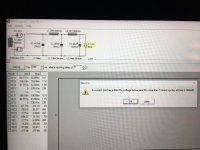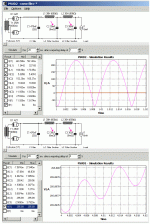First, check your values.
Do you *really* have "30mF" (30,000uFd!) caps?? That seems totally extreme. Or a mis-type.
Second: there are no true "current sources" in audio amp supplies. In this case, with 30,000uFd and "infinite" resistance on the end, PSUD goes on (after you soothe its error) to show a huge 125Hz oscillation which does indeed swing negative.
The "current source" is never realistic. For one, current must be zero at start up. For another, most tube circuits are more like resistors than constant-current loads. Given about 300V and 6mA, replace the CC load with a 50K resistive load. The resistance will damp the apparent oscillation. The result will be close enough for any tube work.
This still shows that "30mF" (30,000uFd) caps are sledgehammers on fleas. It takes *minutes* for the caps to charge-up to hundreds of Volts.
Do you *really* have "30mF" (30,000uFd!) caps?? That seems totally extreme. Or a mis-type.
Second: there are no true "current sources" in audio amp supplies. In this case, with 30,000uFd and "infinite" resistance on the end, PSUD goes on (after you soothe its error) to show a huge 125Hz oscillation which does indeed swing negative.
The "current source" is never realistic. For one, current must be zero at start up. For another, most tube circuits are more like resistors than constant-current loads. Given about 300V and 6mA, replace the CC load with a 50K resistive load. The resistance will damp the apparent oscillation. The result will be close enough for any tube work.
This still shows that "30mF" (30,000uFd) caps are sledgehammers on fleas. It takes *minutes* for the caps to charge-up to hundreds of Volts.
Attachments
Rob's PSUDII tutorial.
I'd recommend viewing that tutorial with 'a grain of salt', both for editorial comment about what a 'good' power supply is, and that the text has some significant mistakes (like when stating that stabilising time is in milliseconds rather than seconds for fig 5, 6 and 7). There are a lot of glorified but unsubstantiated comments, like adding a snubber cap across the power transformer secondary, and his discussion about 'ringing' by looking at power on charge up behaviour with a constant current load.
Some useful info, but some confusion too. Not a good way to start in PSU design.merlin el mago said:Rob's PSUDII tutorial.
For example, he claims that the 'high quality cap' at the output supplies power to the audio amp, yet this is part of a filter with a cutoff around 50kHz. The result is that the cap only supplies the amp for frequencies above 50kHz; below this it has to get its power from the previous cap.
I'd recommend viewing that tutorial with 'a grain of salt', both for editorial comment about what a 'good' power supply is, and that the text has some significant mistakes (like when stating that stabilising time is in milliseconds rather than seconds for fig 5, 6 and 7). There are a lot of glorified but unsubstantiated comments, like adding a snubber cap across the power transformer secondary, and his discussion about 'ringing' by looking at power on charge up behaviour with a constant current load.
I'm wondering if this "overshooting" means anything useful for the simulated psu.
- Status
- This old topic is closed. If you want to reopen this topic, contact a moderator using the "Report Post" button.
- Home
- Amplifiers
- Power Supplies
- power supply simulation

